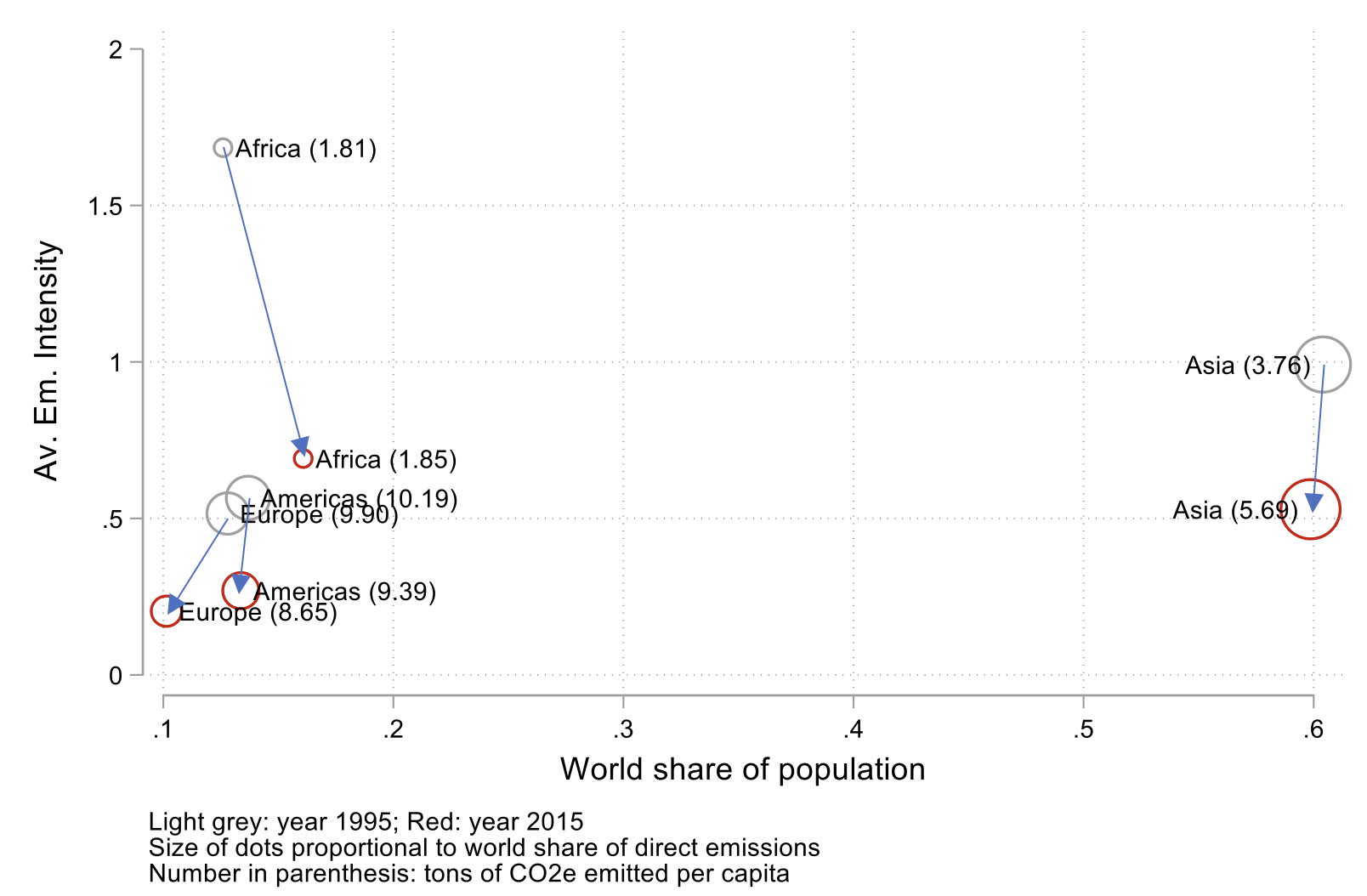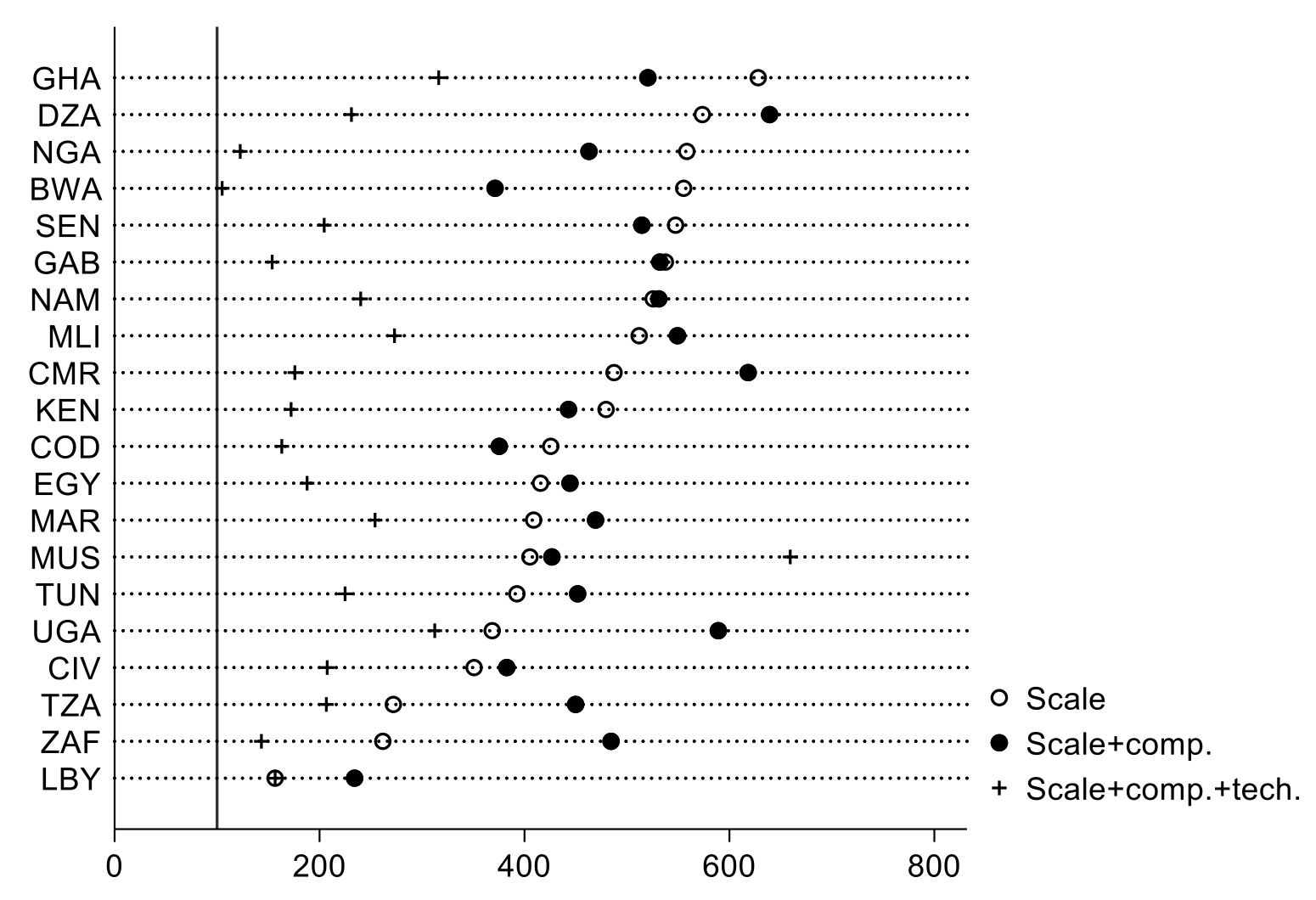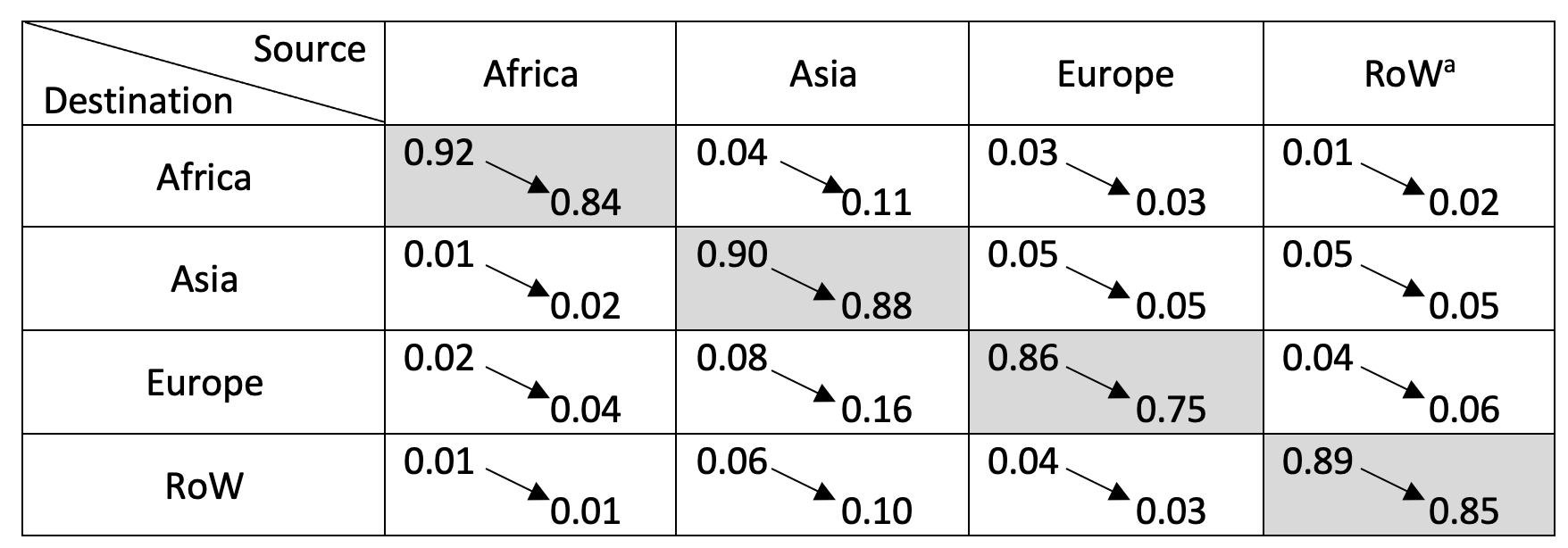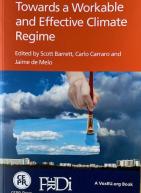To meet the objectives of zero net CO2e (CO2 equivalent) emissions by 2050, high-emitting regions like Asia, Europe and the Americas will have to reduce emissions drastically, while low-income regions like Africa will be encouraged to slow down their CO2e emissions growth. To properly grasp the size of the task ahead, understanding the landscape of emissions and trends is a necessity. Disaggregated data on emissions in Africa are scarce. Cabernard and Pfister (2021) developed the highly disaggregated Resolved Multi-Regional Input-Output (RMRIO) database covering 163 for 189 countries over the time period 1995-2015. In a recent paper (Melo and Solleder 2022), we exploit RMRIO to measure characteristics and patterns of CO2e emissions worldwide. Our focus is on 49 African countries taking a comparative perspective.
In this column, we present key patterns and trends.
Africa has reduced CO2 emission intensities, but decarbonisation has yet to start
Figure 1 plots the average CO2e intensities, measured in kg of CO2e per euro, for each region
against each region’s share of the world population for 1995 (light grey bubbles) and 2015 (red bubbles). The size of the bubbles represents the region’s share of total emissions for a given year. Three patterns stand out : (1) Africa’s share of CO2e emission is the smallest despite an increase in population share between 1995 and 2015; (2) regional average CO2e intensities have fallen across all regions, with the largest decline for Africa, yet Africa still has the highest emission intensity in 2015; (3) Asia, already the largest emitter in 1995, increased its share of world emissions over the period even though both its population share and its average emission intensity declined slightly.
Figure 1 CO2e emissions, population shares, and per capita emissions by region, 1995 and 2015
Source: Melo and Solleder (2022: Figure 1).
Despite having the highest emission intensity across regions, Africa’s per capita CO2e emissions are an order of magnitude lower than those of other regions. Reducing this intensity is of utmost importance as Africa is home to most of the world fastest growing economies and the scope for improvement is rather large: should Africa decrease the CO2e intensity of its ten most carbon-intensive manufacturing sectors to the world’s average levels, the region’s total CO2e emissions would fall by about 5% (Melo and Solleder 2022). Note that sectorial emissions in Africa are generally correlated with the world’s emissions,
so this exercise would not mean that African sectors with high CO2 intensity should reach an unrealistically low intensity.
Africa shifts its production toward more CO2e-intensive sectors
The change in the share of world emissions (bubble size in Figure 1) for each region reflects the combined effects of growth (scale effect), a shift in output across country-sectors with different emission intensities (composition effect), and a technique effect (change in emission intensity within sectors). At the region level, the scale effect is largest in Africa followed by Asia, with no growth in Europe and the Americas. The technique effect accounts for a large reduction in emissions growth. Notwithstanding the decompositions of CO2 emissions by region in Table 1, the large technique effects combined with small composition effects confirm that trade driven by comparative advantage has not been responsible for systematically shifting pollution intensive production out of higher income countries.
A within-country decomposition across the 20 largest emitters in Africa shows that 13 countries have shifted towards more CO2-intensive sectors (‘scale’ larger than ‘scale + composition’ in Figure 2). For many countries, the technique effect was large, but the difference with composition effects is generally small and less than those reported by Copeland et al. (2021: Figure 6), a noteworthy result since RMRIO has a much larger number of sectors than EORA, which should contribute to larger composition effects.
Figure 2 Decomposition of emissions growth for top 20 African emitters, 1995-2015, (scale, composition and technique effects)
Notes: The figure reports the 20 largest scale effects. Countries ordered by descending scale values. Scale represents 100 times value-added in 2015 divided by GDP in 1995. Scale + composition modifies the scale value to keep technique (emission rate) constant for each country*sector as it was in 1995. Scale +composition + technique represent 100 times emissions in 2015 divided by emissions in 1995. Vertical line at “change in emissions” = 100 represents the value of no change in emissions between 1995 and 2015. Angola, Ethiopia, and Zambia excluded.
Source: Melo and Solleder (2022: Figure 3) inspired from Copeland et al. (2021: Figure 6).
These large differences in contributions across countries reflect a continent with the largest number of highly heterogeneous countries, both economically (in terms of size or GDP per capita) and geographically (access to the sea, resource rich or resource poor).
Applying entropy balancing on three characteristics (per capita income, share of manufacturing in GDP and distance from trading partners), we show that the constructed synthetic comparator follows closely Africa’s emission trajectories. This confirms that a few characteristics are good indicators of emission intensities.
Africa’s exports to Europe are becoming more CO2 intensive
Emissions embodied in trade across regions grew sharply for Asia, Africa, and Europe over 1995-2015. Between 1995 and 2015, Asia had the smallest fall in intra-regional trade in emissions, from 90% to 88%. Europe doubled its share of emission from Asia from 8% to 16%, which was mirrored in a sharp reduction in emissions sourced within Europe from 86% to 75%. While these changes in sourcing are not direct evidence of pollution haven effects, the large magnitudes lend support to the often-held view that strict environmental regulations in high income countries lead to relocations towards countries with less strict standards as, documented by Tanaka et al. (2022) in the case of trade in lead batteries between the US and Mexico.
For Africa, the share of CO2e emissions originating from Asia rose from 4% to 11%. Emission shares originating from Europe to Africa and Asia remained unchanged, a reflection of more stringent environmental policies across Europe, but also of relocation of the more emission-intensive activities to Asia. Africa's exports of emissions are low with the highest share destined to Europe.
Table 1 CO2e emissions by source and destination
Notes: a ROW includes the Americas and Oceania. Share of direct (within region) emissions in grey. Numbers rounded to two decimals. Rows sum to 1 (subject to rounding errors). In each cell, upper left number is value for 1995; lower right for 2015. In 2015, Africa sources about 11% of its emissions from Asia and 3% from Europe. Europe sources about 4% of its emissions from Africa.
Figure 3 shows the distribution of production and exports by quartile (about 40 sectors per quartile) ranked by increasing CO2e intensities for Africa and Asia, the two regions with the highest emission intensities. If the distribution of the emission intensities of production by quartiles were the same across regions, each quartile would have 25% of products. With a more upstream production pattern, Africa’s production is concentrated in the less CO2-intensive products. By contrast, Asia’s production structure is skewed towards more CO2-intensive products. The share of CO2e-intensive exports in the most emission-intensive production quartile is much lower in Asia than in Africa. For Asia and Africa, about 7% and 13%, respectively, of exports are in the fourth quartile of emission intensities.
Figure 3 Emission intensities of export and production in 2015: Africa and Asia
Notes: Quartiles order sectors by their world production-weighted average of direct emission intensity. 4 is the most pollution intensive quartile. Year of reference: 2015.
Africa stands out as the only region where export shares and CO2e direct emission intensities are significantly positively associated: an increase in the share of exports of 1% is associated with an increase of direct emissions of 0.07% (Melo and Solleder 2022).
Conclusions
Africa’s carbon equivalent (CO2e) footprint, while following the worldwide downward trend over the period 1995‒2015, is still the highest in the world. At the same time, Africa’s share of global CO2e emissions is the lowest. For over half of the top 20 emitting countries in African, the structure of production has been shifting towards dirty sectors, and, on average, Africa is still carbonising.
The export basket of Africa is skewed towards high CO2e intensity. Almost half of the cleanest and dirtiest sectors are the same across regions. The Spearman rank correlation of 0.7 for sectorial emissions across regions shows promise for decarbonisation efforts at the disaggregated sector level by, for example, a move towards uniformisation of low-emission techniques at the sector level. Should Africa decrease the CO2e intensity of its ten most carbon-intensive manufacturing sectors to world’s average levels, its total CO2e emissions would fall by about 5%.
Because Africa’s carbon footprint is still an order of magnitude lower than in other regions, African countries should not be expected to cut emissions if this cut comes at a cost. However, as urbanisation is just starting in Africa (the urban population share is projected to increase from 47% to 66% by 2050), decarbonising will be a challenge since, on average, per capita CO2 emissions are three times higher in urban than rural areas (Bigio 2015). In addition to providing support for decarbonisation of production, financial support to build a low-carbon urbanisation is called for.
References
Bigio, A (2015), “Towards resilient and low-carbon cities”, in S Barrett, C Carraro and J de Melo (eds), Towards a Workable and Effective Climate Regime, CEPR Press.
Brenton, P and V Chemutai (2021), The Trade and Climate Change Nexus: The Urgency and Opportunities for Developing Countries, The World Bank.
Cabernard, L and S Pfister (2021), “A Highly resolved MRIO database for analysing environmental footprints and green economy progress”, Science of the Total Environment 755(Part 1): 142587
Copeland, B, J Shapiro and M S Taylor (2022), “Globalization and the environment”, in G Gopinath, E Helpman and K Rogoff (eds), Handbook of International Economics, vol. 5, North Holland.
de Melo, J and J-M Solleder (2022), “The Landscape of CO2 emissions Across Africa: A Comparative Perspective”, CEPR Discussion Paper No. 17450.
Porter, M and C van der Linde (1995), “Toward a new conception of the environment-competitiveness relationship”, Journal of Economic Perspectives 9(4): 97‒118.
Tanaka, S, K Teshima and E Verhoogen (2022), “The Cross-border effects of environmental regulation: evidence from battery recycling in the US and Mexico”, VoxEU.org, 21 February.







